In Memory of Christin Gilbert,
1985-2005

Christin Gilbert died from a
botched third trimester abortion obtained at the now
closed Women’s Health Care Services late-term abortion
clinic in Wichita, Kansas. The following narrative is
based on information gathered from the official autopsy
report, 911 communications, members of Christen
Gilbert’s family, first-hand accounts of eye-witnesses
to the emergency transport, and information provided by
a member of a 2006 Sedgwick County grand jury that
investigated George Tiller’s part in the death of
Christin Gilbert.
We remember her life and her
heartbreaking death, with the hope that her tragedy
might prevent others from experiencing her fate. Let her
memory not be forgotten.
Click here for a list of women who have
died from so-called “safe, legal”
abortion.
Christin’s Life

Christin Alysabeth Gilbert was born on May 30,
1985 in Austin, Texas, but spent most of her life in the
small Texas town of Keller. Christin had Down Syndrome,
but that did not stop her from embracing life and living
it to the fullest. Christin was raised by her family,
which consisted of her mother, father, and
sister.
Christin became involved in sports early in her
life because it helped her meet people and make friends.
She became very active in the Special Olympics and
participated proudly for ten years. In 2003, she won the
gold medal in the softball throw.
Christin graduated from the Special Education
Program of Keller High School in 2004. While in high
school, Christin became the inspirational member of the
girl’s softball team, serving as their batgirl. Team
members were never allowed to get down during a tough
game because Christin would meet them at the dugout with
hugs, telling them that she loved them. This kept
spirits high and eventually her team won a state
championship, an accomplishment of which Christin and
her family were especially proud.
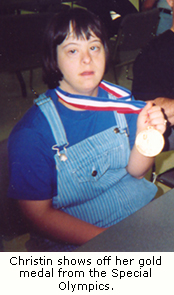
In
life, Christin was a joy to be around. She happily made
everyone who came near her the recipient of her many
hugs. She was the center of attention when she walked
into a room because of her outgoing and loving
spirit.
Christin was loved by all who knew her and her
death has left a void in the lives of her family and
community. Christin was cremated and a private funeral
service was held for her in her hometown of Keller,
Texas, on January 21, 2005. In her obituary, Christin
was called “one of God’s angels.” The 2005 Keller
Special Olympics was dedicated to her memory.
What happened to Christin?
Tragically, sometime in 2004, Christin A.
Gilbert was sexually assaulted in the State of Texas. As
a result of the sexual assault, Christin became
pregnant. A
grand jury was
convened in Tarrant County, Texas, to investigate
Christin’s rape. However, no perpetrator was ever
identified.
Christin’s mother only became suspicious of
Christin’s pregnancy after noticing her enlarged abdomen
while helping Christin bathe. She made an appointment
for Christin with a local doctor, who confirmed that
Christin was with child.
On
Monday, January 10, 2005, Christin was brought by her
family to Women’s Health Care Services, (WHCS), in
Wichita, Kansas, for a third-trimester abortion at 28
weeks of pregnancy.
A
confidential family source told Operation Rescue that
Christin could not have legally consented to sexual
activity because of the severity of her Down Syndrome
condition, and that she never would have chosen abortion
for her baby, leading to concerns that Christin was not
made to understand what was about to happen. Christin
was likely, according to the family member, a victim of
an illegal forced abortion.
Neuhaus’ illegal relationship with Carhart and
his employer, George Tiller

She was evaluated by a doctor who was
purported to the family to be a “psychologist,” Dr. Ann
Kristin Neuhaus, of Lawrence, Kansas. According
to
Kansas law,
post-viability abortions may only take place when there
is an agreement from a second doctor who is not legally
or financially associated with the abortionist.
Christin’s abortionist was LeRoy Carhart of
Bellevue, Nebraska, who was employed by George Tiller,
MD, the owner and medical director of WHCS. At the time
of Tiller’s death on May 31, 2009, he was facing
disciplinary action by the Kansas State
Board for Healing Arts –
which could have resulted in the revocation of his
medical license – on 11 counts of violating this
provision of K.S.A. 65-670. The petition alleged that
Tiller had a prohibited legal and financial relationship
with Neuhaus, who exclusively provided the second
signature for late-term abortions at WHCS from at least
2003, until January, 2007. This includes the time of
Christin’s death. [Note: Solely due to his death, the
Tiller petition has now been
dismissed.]
Carhart begins the third-trimester abortion
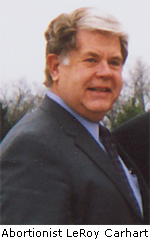
After the possibly illegal Neuhaus
evaluation, Christin was seen by Carhart an employee of
WHCS, who gave her baby a fatal digoxin injection to the
heart. Christin was prepared for labor and delivery of
her dead child. Her cervix was filled with laminaria and
she was sent back to her hotel room at the La Quinta
Inn, located about 1-2 miles from WHCS on East Kellogg
in Wichita. [Note: The La Quinta Inn
terminated their
arrangement to provide accommodations to Tiller’s
patients and his staff in soon after Gilbert’s death.
The hotel has been torn down and rebuilt at a different
location.]
Christin did not eat dinner that evening.
The
following morning, January 11, Christin was loaded into
the family van where she expelled her dead baby on the
way to the abortion clinic.
Christin arrived at WHCS where a D&C
procedure was done on Christin and a “tear in the
uterus” was sutured.
Fatal use of RU 486?
At
this point, Carhart allegedly administered the abortion
drug
RU 486 to
Christin. This drug is approved for medical abortions in
pregnancies prior to the 6th week of gestation. The drug
has been responsible for at least
six deaths in the United States between 2001 and
2006.
RU
486 was apparently meant to be an “insurance policy” to
make sure everything had been expelled from the uterus,
but the drug was not approved by the FDA for that
purpose. RU 486 was also approved as an oral medication,
not as a vaginal suppository, which many believe
contributed to life-threatening complications and deaths
in women who used it in this way. It is believed that
Carhart administered RU 486 to Christin as a vaginal
suppository even though her uterus had suffered a
laceration and was susceptible to infection.
Symptoms that Christin experienced after
the administration of RU 486 were
comparable to the symptoms of other women
who have died from RU 486 nationwide,
which include hemorrhage and sepsis.
Christin’s condition deteriorates
Christin was again sent back to her hotel, which
doubled as both labor and recovery room for Tiller’s
abortion business. This hotel was not equipped to handle
the life-threatening complications that are known to
result from dangerous third-trimester abortions. There,
Christin’s condition began to worsen.
She
returned once again to WHCS on Wednesday, January 12,
and was diagnosed with “dehydration” although the sepsis
was already spreading rapidly through her body. She was
given intravenous fluids, but the clinic staff made no
documentation of her treatment, or how much fluids were
administered to her that day. That lack of documentation
proved to be a prominent factor on the day Christin
died.
Christin was again sent back to her hotel where
her condition continued to deteriorate. Wednesday
evening, the family went out for dinner, but Christin
would not eat.
LeRoy Carhart is missing

Sometime that evening, Christin was
cramping, bleeding, and vomiting, at times passing out.
According to one physician who reviewed the autopsy
report, aspiration of vomitus was the likely cause of
her acute bronchopneumonia mentioned in the
autopsy report.
By
now, Christin was in serious trouble. Between midnight
and 4 AM — there is a discrepancy in the
testimony before the grand jury
that investigated Tiller’s part in Christin’s
death — the family called Tiller employee Cathy Reavis
who was staying at the La Quinta Inn on call. Reavis was
Tiller’s longest employee, having worked for him for 29
years at the time of Christin’s death. Reavis is
identified as Tiller’s “patient coordinator” or “head
nurse,” but she is not licensed in Kansas or any other
state.
Christin was placed into a warm bath, which may
have contributed to extra bleeding and infection. Reavis
then helped get Christin cleaned up and back to bed.
Reavis called Carhart, who was supposedly also
staying at the La Quinta Inn and was on call for
emergencies. Carhart never responded and never saw
Christin at the hotel. The whereabouts of Carhart during
this time is unknown, as is the reason he did not
respond to calls for help.
Final trip to WHCS
The
next morning, Thursday, January 13, Christin’s family
tried to get her ready to go to the clinic. Christin
fainted and could not be revived. Instead of taking her
to the hospital or dialing 911, Christin’s family loaded
their bleeding, unconscious daughter on a luggage rack
and wheeled her to the family van in which they returned
her to WHCS at approximately 8:00 AM.
Once
at the clinic, Christin awakened enough to walk through
the door with assistance, but then collapsed. Her
heartbeat and respiration stopped, or as the
autopsy report stated, “she became unresponsive.”
Some
efforts were supposedly made to revive Christin, but
according to a
grand jury source who inspected the medical records, for the
next 40-45 minutes, there are no notations in the
medical records about the care and treatment of Christin
Gilbert.
Christin’s family was sequestered in a separate
room and was unaware of what kind of treatment their
daughter was receiving.
Possible perjury and a call to 911

Cathy
Reavis testified before the 2006 grand jury that she had
overslept on the morning of January 13, 2005, and was
not at the WHCS until after Christin was taken away to
the hospital. However, former Tiller employee Marguerite
Reed told the grand jury that Reavis met her in the
hallway of the clinic and instructed her to place the
call to 911 that morning. Photographs taken by pro-lifer
Judi Weldy clearly show Reavis’ vehicle in the clinic
parking lot as the ambulance arrived and rounded the
corner of the clinic.
At 8:48 AM on Thursday, January 13,
a 911 call was
placed by Reed, who pleaded with the 911 dispatcher,
“Please, please, please! No lights, no sirens!” She was
evasive with the dispatcher and placed him on hold for
45 critical seconds while she inquired of Reavis about
how much she should tell him. Reavis told Reed that she
couldn’t tell her why, but that she just needed to get
the ambulance. Reed clearly downplayed the true nature
of Christin’s rapidly deteriorating condition. Sensing
no urgency,
emergency responders arrived on the scene
at 8:57 AM, a
full nine minutes after the call was placed.
Paramedics arrive
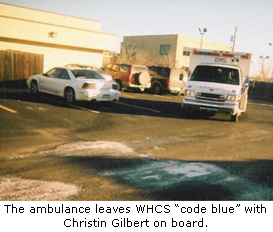
When
paramedics arrived, they saw Christin lying in what was
described as “huge amounts” of “coffee grounds” blood
and fluid — “way more than you would normally see.”
LeRoy
Carhart was on top of her trying to physically force
fluids from her stomach. Paramedics indicated that they
first thought he was a male nurse who may not have known
what he was doing. The paramedics ordered Carhart away
from the girl but he did not comply. A male paramedic
was forced to “very sternly” demand that Carhart step
away from the girl. One report indicated that the
paramedics may have actually pulled Carhart off
her.
The ambulance crew spent 15 minutes treating
Christin’s dire condition, which included cessation of
respiration and cardiac arrest, from which she was
resuscitated. At 9:14 AM, Christin was transported via
ambulance with all haste to Wesley Medical Center’s
Emergency Room, and arrived at 9:18 AM after a four
minute ambulance ride. Pro-lifers photographed the
ambulance at WHCS and George Tiller’s arrival at the
ER.
At Wesley Medical Center

Once at Wesley Medical Center, the
autopsy report showed evidence that Christin was bleeding
from the mouth, vagina, eyes, and every other orifice.
The emergency team who treated Christin worked
aggressively to save her life, but it was too late. The
family was advised of her condition, and reacted by
telling the doctors to harvest her organs for donation.
Huge amounts of antibiotics were pumped into her failing
body, but to no avail. Because the sepsis was not
treated in time, Gilbert suffered from systemic organ
failure. All the blood vessels in her reproductive
organs were clotted.
Christin was given pain medication, but little
else could be done. She was pronounced dead at 4:14 PM,
January 13, 2005.
Christin’s eyes were donated but the rest of her
organs showed signs of hemorrhage and were not suitable
for donation.
Christin’s unclothed body, with medical
implements that had been used in an attempt to save her
life still attached, was sent to the Sedgwick County
Regional Science Center on January 14 for autopsy. Seven
months and ten days later, the report was released to
the public with evidence of her botched
abortion.
Operation Rescue goes public and seeks answers
Operation Rescue broke the story when it
dropped a press release on January 13, 2005, announcing the
documentation of an emergency transport from WHCS.
Efforts to conceal Christin’s death were already
underway. A KNSS reporter was expelled from the WHCS
property after seeking answers about the
incident.
On
January 19, 2005, while conducting a first amendment
activity outside Wesley Medical Center, Troy Newman was
contacted by a member of law enforcement who told him,
under the condition of anonymity, that the abortion
patient that we had seen transported to Wesley on
January 13, had in fact died.
Conversation with Vicki Buening
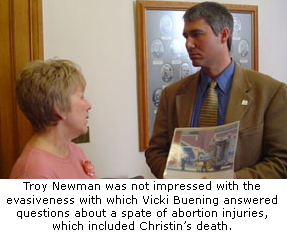
On January 21, 2005, Troy Newman and other
members of Operation Rescue
visited the office of the governor
and spoke with Vicki Buening, the
governor’s Director of Constituent Services. When showed
a number of photos of several ambulance runs from WHCS
to the local hospital, Mrs. Buening told Newman that if
women were unhappy with the care they received at WHCS,
they were free to file a complaint with the Kansas State
Board of Healing Arts. Mrs. Buening was the wife of
Larry Buening, who at that time was the Executive
Director of the Kansas State Board of Healing
Arts.
The
following is an exchange between a visibly nervous Vicki
Buening and Operation Rescue’s Senior Policy Advisor,
Cheryl Sullenger, which took place during that
meeting:
Buening: “Now individuals involved in any of these
kinds of mishandling of their medical care have the
option to file a complaint against their provider with
the Board of Healing Arts.”
Sullenger: “If they’re
still alive.”
Buening: “Certainly that is true.
Whether, uh– [pause] — Yeah, you’re right. But I,
uh…”
Sullenger: “If they are dead, they can’t file
a complaint, can they?”
Buening: “I don’t have an
answer to that question.”
The
impression gathered from that conversation by Sullenger
was that Buening was aware of Christin’s death, but was
hiding it.
Operation Rescue issued a press release on
January 25, 2005, announcing that it had confirmed that
Christin and in fact died from her botched
abortion.
KSBHA complaint filed
Sullenger filed a complaint with the
Kansas State Board of Healing Arts against George Tiller
in the death of Christin Gilbert, since Christin
obviously could not file on her own behalf. Sullenger
received a
letter
dated January 26, 2005, from Shelly
Wakeman, KSBHA Disciplinary Counsel, advising her that
an investigation had been opened based on Sullenger’s
complaint.
Sebelius intervenes for political reasons

Meanwhile, a bill was introduced in the
Kansas House of Representatives,
HB 2503, which
would have placed regulations on clinics that do
abortion. The bill was strongly opposed by then Gov.
Kathleen Sebelius and Tiller’s now-defunct Political
Action Committee, ProKanDo.
Sebelius received large campaign
contributions from Tiller and ProKanDo during her 2002 campaign for
governor.
On
February 2, Sebelius sent a letter to Larry Buening asking him to
look into the death at WHCS.
March 15, 2005, Operation Rescue held
a press conference in the Capitol rotunda opposing HB 2503. A
former Tiller patient told of her horrific experience at
WHCS a number of years ago and of her inability to bear
children since suffering abortion injuries. Sullenger
discussed the death of Christin Gilbert. A legislator
who was present at the press conference believed the
statements would be beneficial to the bill and asked
them to testify before an upcoming committee
hearing.
On March 22, 2005, Sullenger and
Cramer testified before the Senate Public
Health and Welfare Committee in support of HB 2503, even
though Cramer had been contacted by ProKanDo Director
Julie Burkhart in what Cramer viewed as an effort to
intimidate her to keep her from
testifying.
On
March 23, 2005, Operation Rescue issued an e-mail
containing the former Tiller patient’s story along with
Sullenger’s testimony that was distributed throughout
the United States, urging supporters to voice support
for HB 2503.
On March 25, 2005, Larry Buening issued a
letter (pg.
1, 2) to Gov. Sebelius with an “interim” report on
the Gilbert death indicating that their preliminary
determination was that Christin had received care that
“met the standard of accepted medical practices,” even
though the autopsy report had not been released and a
cause of death had not been determined.
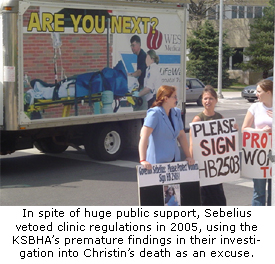
Buening noted in that letter, “The
Board is aware that office-based procedures and clinic
licensure are currently being considered by the
Legislature and wanted to provide you with an interim
report.”
This
statement gives cause to believe that the Buening letter
was politically timed and motivated, and that his
determination was such as to please the
governor.
But
Buening’s efforts to minimize Christin’s death before
the legislature were partly unsuccessful. Later that
day, the Senate passed HB 2503 with an unexpected
two-thirds majority, due in part to the pro-life
testimony, and lobbying efforts made by Operation Rescue
highlighting Christin’s death.
Sebelius later vetoed the bill, basing
her decision in part on the premature conclusions drawn
by Buening in his hastily written letter of March 25,
2005. An attempt to override failed.
Autopsy report released
On August 24, 2005, the autopsy report on Christin’s death was finally filed,
indicating that she “died as a result of complications
of a therapeutic abortion.” The report made no mention
of the names of physicians who treated Christin, nor did
it mention the name of the abortion clinic. Other
autopsy reports filed by the Sedgwick County Coroner
routinely included such information.
KSBHA quietly sweep Christin’s death under the
rug

On the afternoon of November 23, 2005, the
day before Thanksgiving, the KSBHA released its final
determination that absolved Tiller and his staff of
wrongdoing and closing the case both in a detailed
letter to Sebelius [pg.
1,2,3] and in a terser, less informative
response to Sullenger who filed the
original complaint.
After
dismissing the complaint, KSBHA Director Larry Buening
was questioned as to why the official autopsy report
findings were essentially ignored by the Board. Buening
told reporters that the autopsy report released by the
Sedgwick County Forensic Science Center was merely one
“opinion.”
Pro-life groups suspected a cover-up involving
Sebelius, who had received a great deal of campaign
support from Tiller.
Citizen-called grand jury

Unsatisfied with the Board’s decision, and
believing strongly that the determination was
politically motivated, Operation Rescue and Kansans for
Life launched a citizen’s petition to call a
grand jury to
investigate Tiller in the death of Christin
Gilbert.
On
April 19, 2006, the grand jury petitions were certified
and on May 22, 2006, the grand jury convened and began
its investigation.
But on July 31, 2006, District Attorney
Nola Foulston
announced that the grand jury had
dismissed without issuing an
indictment.
Grand jury foreman comes forward with new
information
However, the man who served as foreman on the
grand jury contacted Troy Newman shortly after the grand
jury dismissed and offered an interview. Newman and
Sullenger met the grand jury member and recorded the
interview. Based on his information, Operation Rescue
published via the Internet a four-part series called
“
Justice Aborted,”
which detailed information uncovered by the grand jury
investigation, and revealed the fact that the grand jury
failed to indict Tiller on four counts by only one vote.
That series was published between August 10 and 17,
2006.
In
that interview it was learned that the grand jury had
attempted to subpoena LeRoy Carhart, but was unable to
because Carhart dodged the subpoena, and Asst. District
Attorney Ann Swegle, who was assisting the grand jury,
would not issue the subpoena in Nebraska, where Carhart
lived.

The
grand jury also tried to get a copy of Neuhaus’ record
to see why she thought that Christin’s third-trimester
abortion was legally justified. Swegle told the grand
jury foreman that it would take an “act of God” to get
that record. She made no further efforts to obtain the
record, which impeded the grand jury’s ability to make
an informed decision about the legality of Christin’s
abortion.
KSBHA Arrogance
Two
representatives from the Kansas State Board of Healing
Arts (KSBHA) appeared before the grand jury. One was
attorney Mark Stafford and the other was an unidentified
woman. Their testimony did little to answer questions
about the care Christin received, especially during the
45 minutes she was at the clinic on the day she
died.
“These people all had attitudes,” said a
confidential source inside the grand jury process that
spoke with Operation Rescue. “The people involved from
the Healing Arts, those people were arrogant, ‘We’re
better than you.’ Their attitude was, ‘We can do no
wrong.’
”
Standard Protocol?

The
KSBHA representatives did not reveal details of their
investigation to the grand jury. It seemed that they
expected the grand jury to simply accept their findings,
without question.
“‘You
know what this is, just normal protocol,’ were the words
they all kept using,” said the source.
“‘This is standard protocol, and we had our own
investigator, and he found no fault in what was going
on.’ It was just the whole attitude from all these
people that are in — in my opinion — a small
fraternity.”
But
details that have surfaced indicate that Christin’s
third-trimester abortion was anything but “standard
protocol.” Irregular treatment included a gross misuse
of RU 486, which is approved only for use in early
abortions under six weeks gestation. Abortionist LeRoy
Carhart instead used the dangerous drug, which is
responsible for at least 6 U.S. deaths since 2001, as an
“insurance policy” to make sure the contents of the
uterus were expelled in case Carhart left something
behind after the D&C.
“If a
doctor cannot competently perform a D&C, he is
incompetent to practice medicine,” said Operation
Rescue’s Troy Newman. “There is just no gray area here
or any question. Carhart’s misuse of RU 486 put
Christin’s life at risk and may have killed her. That is
not ‘standard protocol’ in anyone’s book.”
Also
irregular was the lack of notation as to the amount of
fluids Christin received for dehydration on the second
and third days of her abortion, and the lack of
documentation of the treatment Christin received during
the 45 minutes she was at Tiller’s clinic on the day she
died.
“Is
it standard protocol to pump someone’s stomach when she
hasn’t been breathing or had a heartbeat for 40 minutes?
Is it standard protocol not to call 911 for 40 minutes
after someone has gone into cardiac and respiratory
arrest? Is it standard protocol to omit from a patient’s
chart the care received, especially during a fatal
incident?” asked Newman. “These questions were not
answered by the KSBHA or any other witness.”

The
grand jury source indicated that the jurors were given
the run-around by KSBHA witnesses. “‘No, no, no, we had
our own investigator, Mr. So-and-so, da,-da, da-da,
da-da.’ And that’s really how this thing went,” said the
source. The KSBHA representatives expected the grand
jury not to question their findings, and addressed
questioning with condescension.
“The
thing was just — from the Healing Arts people we
interviewed — it’s like there is no ‘wrong.’ But yet,
there’s someone dead over this,” said the
source.
“Three and Out”
The
grand jury was told that the KSBHA has a “three and out”
policy, meaning if a doctor appears before the Board
three times and is convicted, he loses his
license.
It
was asked how many times Tiller had appeared before the
Board. The response was seven times.
“We
asked, ‘Well, what happened to your ‘three and out’
policy?’ ‘Well…’ and they go into their little
justification of Tiller,” the source said.
When
the source was asked if he believed that the KSBHA was
covering for Tiller, the source said, “That’s right!
That’s exactly what it is.”
New investigation requested

Based
on the new information that surfaced after the KSBHA
closed the complaint against Tiller, Operation Rescue
became convinced that LeRoy Carhart was primarily
responsible for Christin’s death and that Tiller was
only minimally involved in Christin’s abortion, yet bore
some responsibility as Carhart’s employer and as the
owner and medical director of WHCS.
In April, 2008, the Executive Director of
the Kansas State Board of Healing Arts
Larry Buening resigned
under pressure and amid scandal for
failure to discipline physicians. Buening was a personal
friend of George Tiller, and was allegedly responsible
for allowing the
improper Neuhaus
relationship to be overlooked by the Board. The next
day, General Counsel
Mark Stafford also resigned. Stafford had repeatedly
stonewalled pro-life groups as they sought answers and
demanded action in Christin’s death.
These
resignations led to a wholesale purging of the KSBHA
that took place over the course of several months.
Former Tiller and Sebelius cronies were replaced
with an executive staff that did not have the
connections to the abortion lobby.
Operation Rescue believed that the investigation
into Christin’s death under Buening was politically
timed and its determinations politically motivated,
casting suspicions on the Board’s determination to close
the case. After the Buening/Stafford resignations and
other personnel changes, the Board appeared to have been
purged of corruption. Because of this, Operation Rescue
filed a complaint in February, 2009, asking that the
inquiry into Christin’s death be reopened, this time
focusing on Carhart’s role in her abortion. However, the
KSBHA later notified OR that it would not reopen the
case.
WHCS permanently closes
Then
on March 31, 2009, Tiller was murdered in Wichita,
Kansas, an act of violence strongly denounced by
Operation Rescue. The Tiller family made the decision to
permanently shutter WHCS, an action that closed a
chapter in the nation’s debate over late-term abortions
and liberated Kansas from the reputation as the Abortion
Capital of the World.
LeRoy
Carhart then promised to begin providing late-term
abortions at his abortion clinic in Bellevue, Nebraska,
while he continued some attempt at reopening a late-term
abortion mill somewhere in Kansas.
As of
this writing, however, neither of Carhart’s plans have
come to fruition. Currently, there remains no one in
Kansas that will provide post-viability
abortions.
Christin Gilbert’s death was a catalyst that
helped open the eyes of the people of Kansas, including
the Legislature, to the horrors of late-term abortions.
If her story can warn others and spare even one life,
then her death was not in vain.
